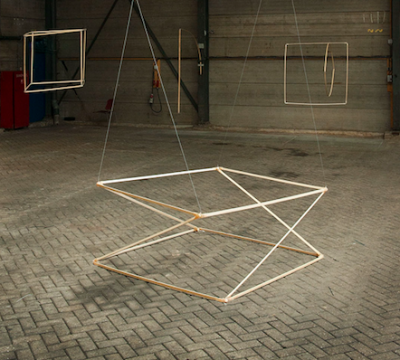maria blaisse
Since her graduation from the Gerrit Rietveld Academy, Maria Blaisse (Amsterdam, 1944) has developed an entirely individual language of form. However varied her work, one can always recognise the hand of Blaisse. Her designs find themselves on the intersection of art, design, textile and fashion, finding their way to the theatre, museum, art gallery and even the Parisian catwalk.
Several years ago, Blaisse began to experiment with bamboo. She loves the mobility and dynamic of bamboo. She obtains that mobility through the use of braiding techniques.
Maria Blaisse studied at the Rietveld Academy in Amsterdam. She taught textile design at the same academy for a long period and developed into a versatile designer and international guest tutor. Places where her work has been shown include Eindhoven, Amsterdam and Jerusalem.
Bamboo in motion
She is the artist with the most beautiful eyes. When Maria Blaisse looks at you, it is as though she emits light. Her look is intense, wide open, curious and yes: much like that of a schoolgirl. And yet, Maria Blaisse (1944) is not a spring chicken, she has seen much of the world. After her graduation as a designer from the Rietveld Academy in Amsterdam in 1968, Blaisse developed into an internationally respected and highly driven artist, who has exhibited and taught masterclasses in many a place inside and outside The Netherlands.
After the Rietveld, The Netherlands become too small for her. She travels to the centre for contemporary art in the sixties and seventies: New York, where she is offered an apprenticeship with groundbreaking textile designer Jack Lenor Larsen. Two years later, she moves onto Peru, to research natural colouring methods and pre-Columbian textile art. Then follows Japan. She instantly identifies the spiritual eloquence of the Japanese minimalistic aesthetics as ‘home’. Subsequently, she journeys to Africa, where she sees bamboo forests so high, so sheerly rustling and so flexible that she knows: I must do something with this someday.
Maria Blaisse is an artist whose work viscerates the line between design, architecture and autonomous art. She gained fame as the designer who created hats from car tires. When, during the seventies, she needed to make one of her children a fire helmet with large flaps, she discovered the circular shape of the car tire. A simple incision in the material opens up an ocean of possibilities.
The (shape of the) car tire — a toroid — has long since been her trademark, although the tire itself is barely identifiable in Blaisse’s designs anymore. The motion released by cutting the toroid open forms the basis of her work. That work consists of black and primary coloured hats, which featured in fashion shows by Issey Miyake during the eighties. It encompasses large, circular, ‘breathing’ objects, architectonic constructions, bags, glass objects and minimalistic items of clothing that are worn in dance performances, yet at the same time serve as autonomous parts of the performance.
Since 2007, Blaisse has been exploring bamboo alongside rubber as material. In construction, one mostly finds bamboo as an alternative to wood, but specifically the flexibility of the material has a stirring splendour, according to Blaisse. She applies this quality to her architectonic designs, in dance performances and in autonomous art, like here in the Noletloodsen.
In Traveling Geometry, as her new work is called, Blaisse experiments on from a dance performance in 2015 in the BIMhuis in Amsterdam. During that performance (of which a fragment can be found on Vimeo: https://vimeo. com/137596829) one sees two dancers enter into ‘conversation’ with a few simple bamboo constructions: a square, an oval, a circle, a line. Throughout the dance, those shapes shift from three to two dimensions and back again. Incredibly long and flat becomes, with the slightest of touches, fascinatingly high and deep.
This, too, occurs to the seven geometric shapes in Schiedam, which Blaisse has attached to a construction hanging from the roof of the warehouse with the help of Chinese designer Bin Xu. Bin Xu is responsible for the semi-mechanic, semi-digital technique that causes a circle, cube, rectangle, t-square and an oval (among other forms) to continuously change shape. The piece of work ‘travels’ from two to three dimensions, from large to small and back again, from flat to deep, from low to high. Bamboo is light as a feather and begets with Blaisse the allure of silk. Spotlights allow the bamboo objects to throw dancing shadows across the wall and the floor.
A pathway leads the viewer through this constantly changing bamboo forest. Traveling Geometry appears so simple: the interference is minimal, the shapes overfamiliar. And yet the effect is graceful and stunning. From the daily excesses that surround us, Blaisse distills a few simple basic forms.
Within that simplicity, she searches for the boundaries of muchness. The fact that she succeeds in this, is due to her ability to watch closely, see clearly and subsequently work thoughtfully on that which she sees.


